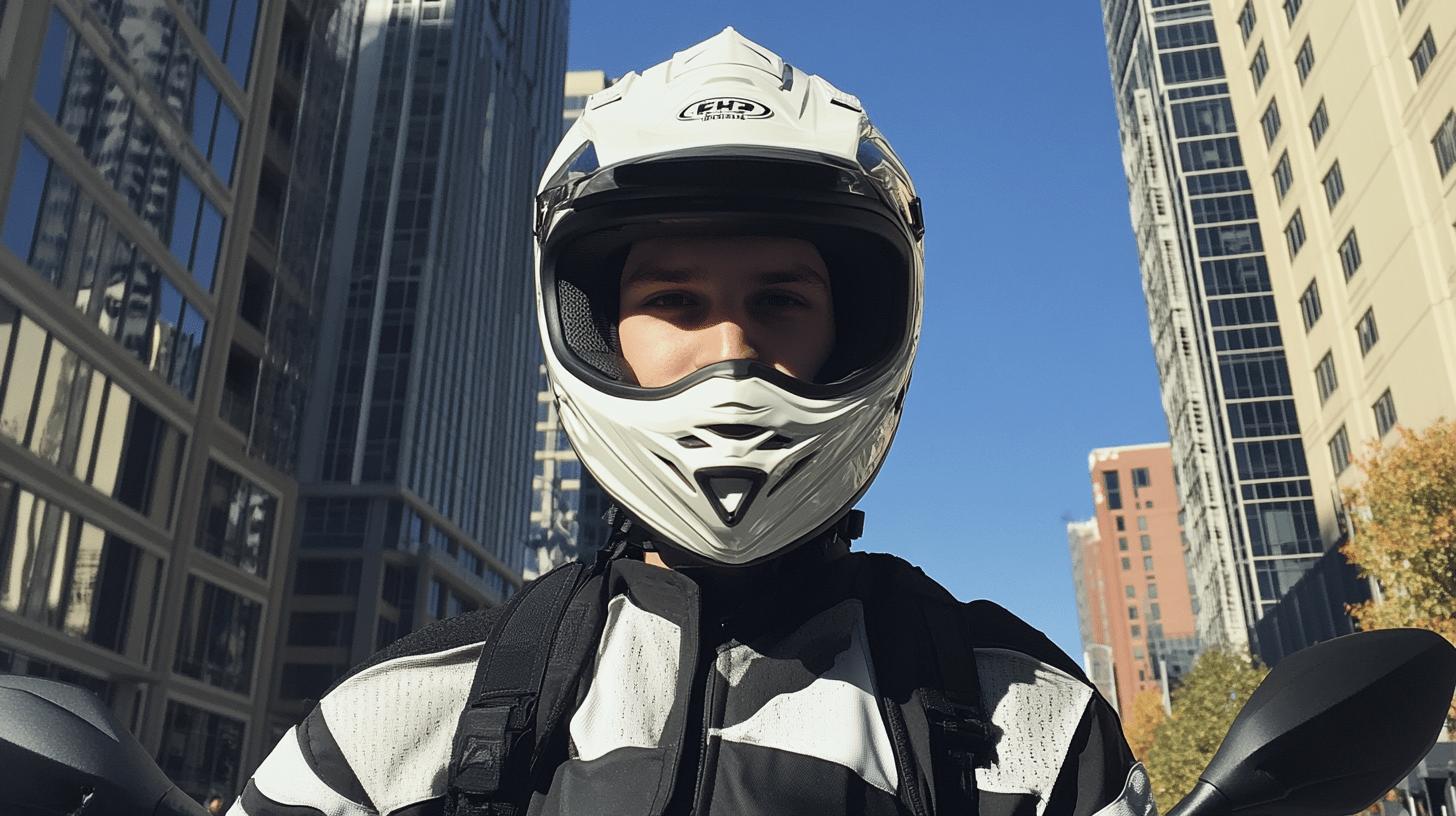Are you ready to hit the open road, but wondering about which states require motorcycle helmets? Navigating the patchwork of helmet laws across the U.S. can be confusing and surprising.
Laws vary widely—from states enforcing universal helmet mandates to others having none at all. This pivotal distinction not only affects your riding experience but also your safety and legal standing.
Dive into the complexities of helmet regulations to understand where you must strap on a helmet and the potential consequences of neglecting this critical piece of gear.
Overview of Motorcycle Helmet Laws in the U.S.

Motorcycle helmet laws play a crucial role in safeguarding riders' lives by minimizing the risk of severe head injuries during accidents. These laws aim to enhance road safety, protecting not only motorcyclists but also other road users. Helmets are proven to reduce the risk of head injury by 69% and the risk of death by nearly 42%, highlighting the importance of these regulations.
In the U.S., motorcycle helmet laws differ widely across states, with regulations often contingent upon factors such as age and passenger requirements. Some states mandate helmet use for all riders, ensuring maximum protection regardless of age.
Others adopt partial helmet laws, requiring helmets primarily for younger riders, typically those under 18 or 21. Specific exemptions may apply, such as for riders meeting certain insurance criteria or those operating motorcycles with specific engine capacities. States like Illinois, Iowa, and New Hampshire have no helmet laws, leaving the decision to the rider's discretion.
- Age of the rider
- Type of motorcycle
- Passenger requirements
- Health insurance coverage
- Engine capacity
- State-specific safety records
Helmet laws significantly impact rider safety and compliance. States with universal helmet laws tend to report lower rates of motorcycle-related fatalities and severe injuries. Compliance with these laws not only reduces the risk of life-threatening injuries but also shields riders from potential legal penalties, such as fines and points on their driving records. By adhering to helmet regulations, motorcyclists contribute to a safer riding environment and promote responsible road behavior.
States with Universal Helmet Laws

In the United States, universal helmet laws mandate that all motorcyclists wear helmets, regardless of age or experience. As of 2024, 18 states have such laws in place, along with the District of Columbia.
These states are Alabama, California, Georgia, Louisiana, Maryland, Massachusetts, Mississippi, Missouri, Nebraska, Nevada, New Jersey, New York, North Carolina, Oregon, Tennessee, Vermont, Virginia, Washington, and West Virginia. These laws ensure that every rider, whether a driver or passenger, is required to wear a helmet, promoting consistent safety standards across the board.
The primary rationale behind universal helmet laws is to enhance motorcyclist safety. By requiring helmet use for all riders, these states aim to minimize the risk of severe head injuries and fatalities resulting from motorcycle accidents.
Helmets are statistically proven to reduce the risk of head injury by a significant margin, making them a critical component of rider safety. Universal helmet laws also help simplify enforcement and compliance, removing ambiguity about who must wear helmets, thereby encouraging a culture of safety and responsibility among all motorcyclists.
States with Partial Helmet Laws

Partial helmet laws are prevalent in 29 U.S. states, where the requirement to wear a helmet is primarily determined by the rider's age or other specific conditions. Typically, these laws mandate helmet use for younger riders, usually those under the ages of 18 or 21. This approach balances safety concerns with personal freedom, particularly for adult riders.
However, many states also include additional exemptions, such as for riders who meet certain health insurance criteria or those operating motorcycles with low engine capacities. While these exemptions provide flexibility, they can also introduce complexity in compliance and enforcement.
-
Texas: Helmets required for riders under 21.
-
Florida: Riders under 21 must wear helmets; exemption for those over 21 with minimum $10,000 in medical insurance.
-
Pennsylvania: Helmets mandatory for riders under 21; those over 21 can ride without a helmet if they have two years of riding experience or have completed a safety course.
-
Michigan: Riders under 21 must wear helmets; those over 21 may not need a helmet if they have additional insurance.
-
South Carolina: Helmets required for riders under 21.
-
Kentucky: Helmets mandatory for riders under 21 or those with a permit.
-
Arizona: Helmets required for riders under 18.
-
Ohio: Helmets mandatory for riders under 18 and for those with a learner's permit.
Partial helmet laws influence rider safety and decision-making significantly. While these laws aim to protect younger riders who may be more vulnerable due to inexperience, they also offer adults the choice to ride without a helmet under certain conditions.
This flexibility can lead to increased personal responsibility for safety among adult riders. However, it may also result in higher risks, as riding without a helmet increases the likelihood of severe injuries in accidents. Riders in states with partial helmet laws should weigh the risks and benefits carefully, considering both personal safety and legal implications.
States with No Helmet Laws

In the United States, three states—Illinois, Iowa, and New Hampshire—stand out for having no motorcycle helmet laws. This absence of legislation grants riders the freedom to choose whether to wear a helmet, emphasizing personal responsibility and autonomy.
However, riding without a helmet can significantly increase the risk of severe head injuries and fatalities in accidents. The freedom to ride helmet-free may appeal to some, but it also raises safety concerns. Motorcycle advocacy groups play a pivotal role in these states, often influencing helmet law decisions by advocating for rider autonomy and opposing mandatory helmet laws.
These groups argue for the riders' right to make personal safety choices, impacting legislative discussions around helmet requirements. While these states offer motorcyclists the liberty to decide for themselves, the absence of helmet laws necessitates a heightened awareness of the safety risks involved in riding unprotected.
Penalties and Compliance with Helmet Laws

What are the penalties for not wearing a helmet in states with helmet laws? Fines and points on a driver's license are common penalties for non-compliance. While fines can vary significantly, ranging from $25 to over $100 depending on the state, accumulating points on a driver's license can have more lasting effects.
These points can contribute to higher insurance premiums and may even lead to license suspension if an excess number is accumulated. Some states also impose additional penalties, such as mandatory safety courses or community service, to reinforce the importance of helmet use.
Compliance with helmet laws is crucial to avoid legal implications and enhance personal safety. Following these laws not only minimizes the risk of incurring fines and other penalties but also significantly reduces the chance of sustaining serious injuries in an accident. Non-compliance can have broader impacts, such as affecting insurance claims.
Many insurance companies factor in helmet use when determining liability and compensation, meaning non-compliance could result in reduced coverage or denial of claims. Therefore, adhering to helmet laws is not only a legal obligation but also a practical step in ensuring both personal safety and financial protection.
The Impact of Helmet Laws on Safety and Accidents

How effective are helmets in preventing motorcycle injuries and fatalities? Wearing a helmet reduces the risk of head injury by 69% and the risk of death by nearly 42%. Moreover, helmets are estimated to be 37% effective in preventing fatal injuries to motorcycle drivers. These statistics underscore the critical role helmets play in enhancing rider safety during accidents.
Helmet laws significantly contribute to reducing the number of injuries and fatalities among motorcyclists. States with strict helmet laws report lower incidences of severe head injuries and motorcycle-related deaths. The enforcement of these laws encourages consistent helmet use, which directly correlates with increased rider protection.
The presence of universal and partial helmet laws serves to reinforce the importance of wearing helmets, ensuring that riders are better protected on the road. These laws not only aim to save lives but also help reduce the economic burden associated with motorcycle accidents, which often involve costly medical treatments and long-term rehabilitation.
-
Reduces the severity of injuries in crashes.
-
Lowers the overall number of fatalities.
-
Encourages a culture of safety and responsibility.
-
Decreases the financial impact of motorcycle accidents.
-
Improves the efficacy of emergency medical responses by minimizing critical injuries.
By mandating helmet use, these laws ensure that riders are equipped with the necessary protection to mitigate the risks associated with motorcycle riding. This proactive approach to safety has a profound effect on reducing the overall harm from accidents, ultimately leading to safer roads for all users.
Recent Changes and Trends in Helmet Legislation

Helmet law updates for 2024 reflect a growing emphasis on safety and public awareness. Recent legislative trends indicate a shift towards stricter enforcement of existing laws, with several states considering adjustments based on new safety data. Proposals for helmet law reform are gaining traction, focusing on expanding mandatory helmet use to include broader age groups and specific riding conditions.
These changes are informed by statistics demonstrating the effectiveness of helmets in reducing fatalities and serious injuries. Certain states are also exploring the introduction of enhanced penalties for non-compliance, aiming to increase adherence to helmet regulations through heightened deterrents.
These legislative developments could significantly impact motorcyclists by mandating more consistent helmet use and potentially altering current riding practices. Motorcyclists may need to adapt to evolving regulations, ensuring compliance to avoid legal repercussions and maintain safety.
The trend towards stricter laws underscores the importance of helmets as a critical safety measure, encouraging a culture of responsibility among riders. As states continue to refine helmet legislation, motorcyclists must stay informed about local requirements and adjust their safety practices accordingly to align with these emerging legal standards.

What challenges do motorcyclists face when traveling between states with varying helmet laws? The primary challenge is ensuring compliance with state-specific helmet regulations. Each state has its own set of rules, which can range from universal helmet mandates to partial or no helmet laws at all.
This lack of uniformity can lead to confusion among riders, especially when crossing state lines. Riders must be aware of the helmet requirements in each state they travel through to avoid legal penalties, such as fines or points on their driver's license. Additionally, non-compliance can affect riders' safety and insurance claims in the event of an accident.
-
Check each state's helmet law before traveling.
-
Use apps or websites that provide up-to-date helmet law information.
-
Carry a helmet at all times to ensure compliance across different states.
-
Familiarize yourself with the local enforcement practices related to helmet laws.
-
Attend safety courses that cover multi-state travel requirements.
-
Consult with local riding groups for insights on regional regulations.
Resources for riders to check state-specific helmet requirements are crucial for maintaining compliance and safety. Many online resources, such as government websites and motorcycle advocacy groups, offer detailed information on each state's helmet laws.
Mobile apps designed for motorcyclists can also provide real-time updates on helmet regulations, ensuring riders are always informed. By leveraging these resources, motorcyclists can navigate the complexities of state helmet laws effectively, promoting a safer and more responsible riding experience across regions.
Final Words
Understanding what states have motorcycle helmet laws is essential for navigating the diverse regulations motorcyclists face across the U.S. With 18 states enforcing universal laws and 29 having partial regulations, riders must adapt to varying requirements.
The safety benefits of helmet use are clear, significantly reducing injuries and fatalities. Staying aware of these laws enhances safety, ensures compliance, and fosters a positive riding experience. Embrace helmet regulations as beneficial protection for every journey.
FAQ
Which states can you ride a motorcycle without a helmet?
Three states, Illinois, Iowa, and New Hampshire, have no motorcycle helmet laws, allowing riders to choose whether or not to wear a helmet.
Do motorcycle riders have to wear a helmet?
The requirement varies by state. Some states mandate helmets for all riders, while others have age-based exemptions or no requirement at all.
Is it illegal to ride a motorcycle without a helmet in Utah?
In Utah, riders under the age of 21 must wear helmets. Adults aged 21 and over are not required by law to wear a helmet.
What are the motorcycle helmet laws in Florida?
In Florida, riders over the age of 21 are exempt from wearing a helmet if they carry at least $10,000 in medical insurance coverage.
What is the Ohio motorcycle helmet law?
Ohio mandates that riders under 18 and those holding a "novice" license wear helmets. All passengers must wear helmets when the operator is required to do so.
What is the Arizona motorcycle helmet law?
Arizona requires helmets for riders and passengers under the age of 18. Riders 18 and over are not required by law to wear helmets.
Which US states do not require motorcycle helmets?
The states without universal helmet laws include Illinois, Iowa, and New Hampshire, where no helmet requirements exist for motorcyclists.
What states require bike helmets?
Several states mandate bicycle helmets, primarily for younger riders. Laws vary widely, with some states enforcing helmet use for riders under a specific age.
Are Slingshot helmets required by state?
Helmet requirements for Polaris Slingshot vehicles depend on state laws and whether the vehicle is classified as a motorcycle or autocycle.
What are the Maine motorcycle helmet laws?
Maine requires helmets for riders and passengers under 18, those with a learner's permit, or within the first year of licensure.
What are the penalties for not wearing a helmet where required?
Penalties often include fines and potentially points on a driver’s license. These consequences depend on the specific state’s enforcement policies.

Ryan Thompson is a 35-year-old sport bike enthusiast known for his adventurous spirit. With years of weekend rides and exploring new roads, Ryan brings fresh insights and firsthand experience to ProtectiveGearz. His energetic approach and passion for the latest gear make him a trusted source for riders seeking up-to-date advice.



